Inside Australia’s plan to survive bigger, badder bushfires
Unprecedented wildfires are breaking out all over the world. Is Australia leading the way in fighting them?
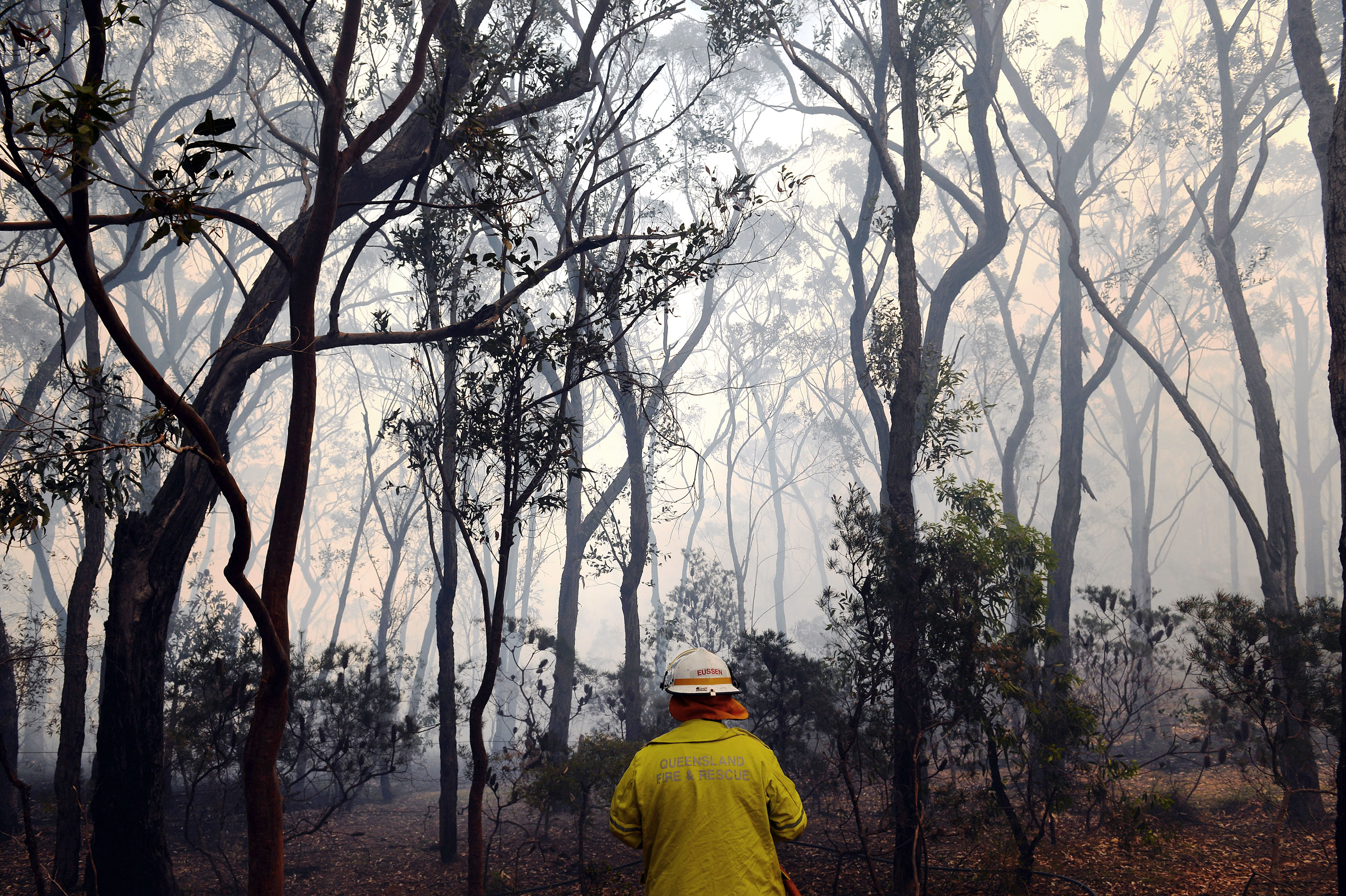
The Blue Mountains are burning. I stand in the doorway of our home and take a long look around: the handmade rugs, the jumble of artworks, the shelves crammed with books, the scattered toys. The house is a tinderbox: wooden walls, doors, balcony, window frames, all built into a lushly forested hillside. I picture all of it flaming into indistinguishable piles of ash.
“Please don’t burn,” I whisper, as if it will make a difference.
I lock up, and join my husband and two children in a car laden with what few precious items we could cram into it.
It’s October 21, 2013, and not one but three wildfires are roaring through the eucalyptus forests. The oil-infused leaves of the gum trees are what lend the Blue Mountains their characteristic hue—but they also make them particularly combustible. The authorities have issued a chilling warning to 80,000 people across 27 mountain villages: Nobody, not even the fire service, can guarantee your safety, and the best course of action is to get out.
So we do.
In the end, our town was spared. And while the blazes eventually claimed more than 200 houses around the fringe of the wilderness, mercifully, they took no lives.
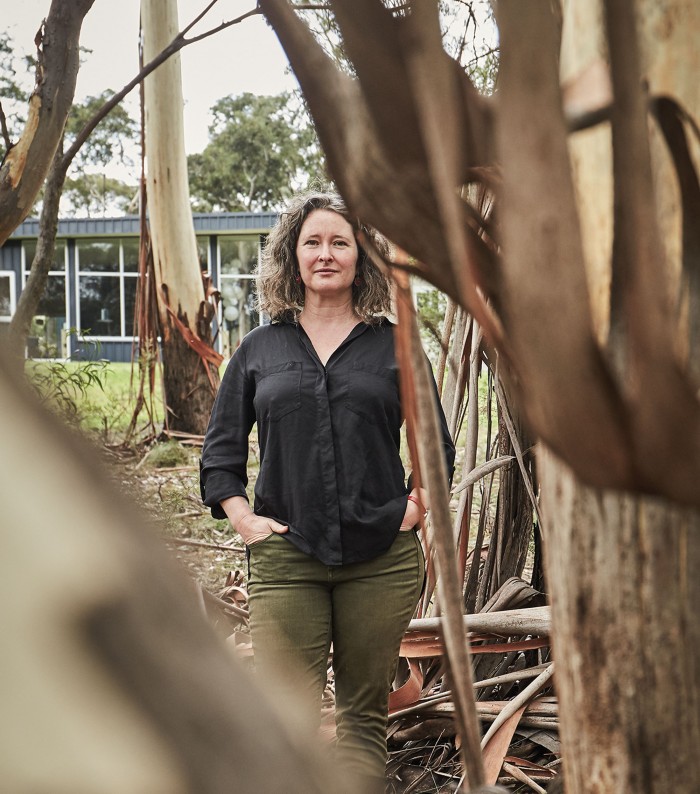
Australia’s colonial history is dotted with fires so enormous they have their own names: Black Sunday (1926), Black Friday (1939), Black Tuesday (1967), and Ash Wednesday (1983). The worst, Black Saturday, struck the state of Victoria on February 7, 2009. Fifteen separate fires scorched the state over just two days, fueled by a record-breaking heat wave, strong winds, and a desiccated landscape. The flames razed entire towns and killed 173 people. Compared with all these, my Blue Mountains experience barely rates a mention.
“Australia’s certainly one of the most flammable continents,” says Geoff Cary, an associate professor of bushfire science at the Australian National University. That is true, but the country is not alone in facing terrible fires. In recent years California, Chile, and British Columbia have all been ravaged by record-breaking blazes. Even nations where wildfires are unfamiliar—such as Sweden and the United Kingdom—have seen unprecedented outbreaks, blamed on rare heat waves and droughts.
In fact, while Australia is notorious for spectacular blazes, it actually ranks below the United States, Indonesia, Canada, Portugal, and Spain when it comes to the economic damage caused by wildfires over the past century.
There is one significant difference, however. While other nations argue about the best way to tackle the issue, the horrors of Black Saturday led Australia to drastically change its response.
In its final report, the Black Saturday Royal Commission—which interviewed more than 400 witnesses—said that it would be a mistake to treat the tragedy as a one-off event. “With populations at the rural–urban interface growing and the impact of climate change, the risks associated with bushfire are likely to increase,” it said. Since then there have been significant changes, including new approaches to house design and construction, and shifts in urban planning, evacuation policy, and emergency warning systems.
And one of the biggest changes was also one of the most basic: taking another look at the way fire risk is rated.
Beyond extreme
Australia’s Fire Danger Index was developed by local fire researcher Alan McArthur and has been in use since 1967. It uses humidity, temperature, wind speed, and long- and short-term drought effects to gauge the risk and potential severity of fire. Originally, the highest level of warning was “Extreme.” But in 2009, the authorities added a new, higher tier: “Catastrophic/Code Red.”
Today, Black Saturday–type weather is a one-in-20-year event. “In any given season there’s roughly a 5% chance that we’ll get a clanger of a day like that,” says Justin Leonard, a research leader in bushfire urban design at CSIRO, Australia’s government science agency. But by 2050 that is projected to increase to a 15% chance. By 2100, it’s around 30%.
That’s why Code Red was introduced, as another level to reflect the fact that bushfires are getting worse, and that new responses are required.
“If Black Saturday taught us anything, it’s that some fires are bigger than others, and that they’re not something that you want to be standing in front of and trying to defend your house on those days,” says Richard Thornton, CEO of the Bushfire and Natural Hazards Co-operative Research Centre.
Code Red is an admission that there are some blazes rescuers and firefighters simply cannot tackle, and that the vast majority of homes are not designed to withstand. It signals that leaving your property well before the fire front approaches is the best option for survival; two thirds of the victims of Black Saturday perished in or near a house. Code Red means Get out early.
“In the Victoria region, the inevitability that a big fire will run on that day is nearly absolute—it just depends where in the landscape it’s going to turn up,” says CSIRO’s Leonard. “In a sense we’re abandoning, and resigning to the inevitability that when we have those days, we’re going to lose thousands of houses and hopefully only one or two people.”
Accepting that grim reality doesn’t mean Australians are willing to lose buildings completely, however.
Building and rebuilding
The enormous metal chimney jutting out from the jumbled complex of low white buildings on Sydney’s leafy north shore is the first clue that CSIRO’s fire testing facility is a little out of the ordinary. This is where experts are testing and measuring a new generation of building materials to see if they are strong enough to survive the Code Red future.
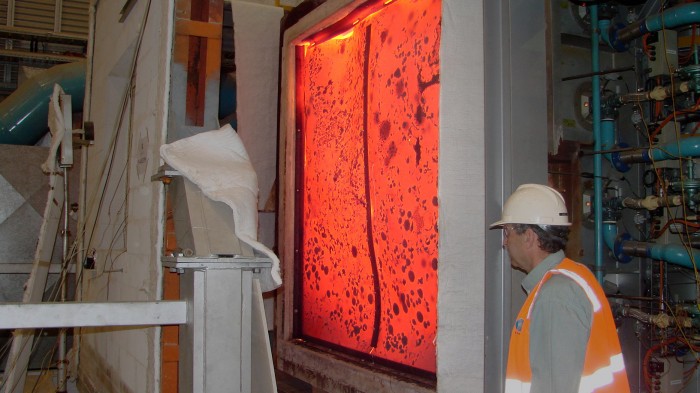
The site’s centerpiece is a blackened gas-fired furnace three meters square, its inside mottled with drips of what I discover is melted concrete. (No, I didn’t know concrete could melt either.) This is where windows, doors, and other housing components are tested to see if they can withstand the destructive power of a full-throttle bushfire: temperatures reaching 1,300 °C (nearly 2,400 °F) and radiant heat over 100 kilowatts per square meter. For comparison, just 2 kW per square meter is enough to cause second-degree burns to bare skin.
Testing a window for bushfire resistance involves first building it into a brick frame and then placing it a carefully calibrated distance from the furnace. A sheet of stainless steel four millimeters (0.16 inches) thick sits between the window and the furnace to make sure the blast of heat is uniform.
The temperature cranks up, but the test isn’t just about surviving the initial onslaught of heat. A window or shutter going through this process has to maintain its integrity for at least 30 minutes after the heat is switched off. Any cracking, warping, or reignition during that cool-down period results in an automatic fail.
It’s an expensive process—a single test can cost around AU$16,000 (US$11,300), regardless of the outcome. The steel radiation sheet must be replaced every few tests, and the gas bills are enormous. “This place is pretty harsh on everything,” says Brett Roddy, a CSIRO lab manager, with a laugh. “We have to replace a lot: lights, people, kit.”
My own house—the one I briefly abandoned in 2013—wouldn’t have the faintest chance of passing any of these tests, with its wooden window frames, decking, cladding, and door. But since 2009, there have been much more stringent rules for any house built within 100 meters of fire-prone vegetation.
I discovered this shift myself in 2015, when we built a new home on a block of land in another part of our small town.

There are six levels of bushfire exposure, from Low to Flame Zone. Our new home, thanks to the dense, sloping eucalyptus forest just 30 meters away, is in the second highest category, known as Bushfire Attack Level 40, or BAL-40. Getting building approval meant meeting the new requirements: a steel-clad exterior and roof, a completely enclosed subfloor area, and bushfire-tested windows, doors, and skylights.
“I just got a Flame Zone house costed, and it was AU$300,000 (US$213,000) just for windows,” says Ingrid Donald, the Blue Mountains architect who designed our new home.
The regulations are not about making a house “bushfire-proof” but ensuring that it survives well enough to protect its occupants, should they find themselves sheltering in it when the fire front passes. The most recent innovations are products such as steel window shutters and low-carbon, fiber-reinforced cement composite board—construction materials that can perform better in the face of a terrifying blaze.
Some people, though, are thinking more ambitiously. Sean O’Bryan, a partner at Baldwin O’Bryan Architects, suggests that the answer is in a more radical kind of earth-sheltered house. “We’re pretty confident we can design buildings that are completely bushfire-proof,” he says. The houses his firm designs are covered with a minimum of 500 millimeters of soil. “You just get all that mass of insulation from the heat of a bushfire,” O’Bryan says. The only outward-facing elements are windows: “Obviously the windows have to got to be protected in different ways … but we can get them to a point where we just put shutters over the front of them.”
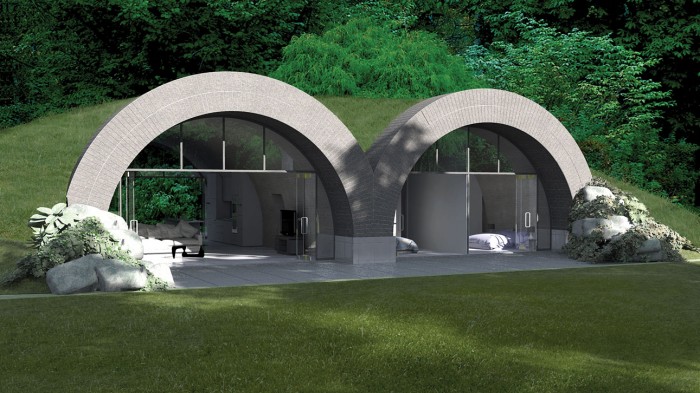
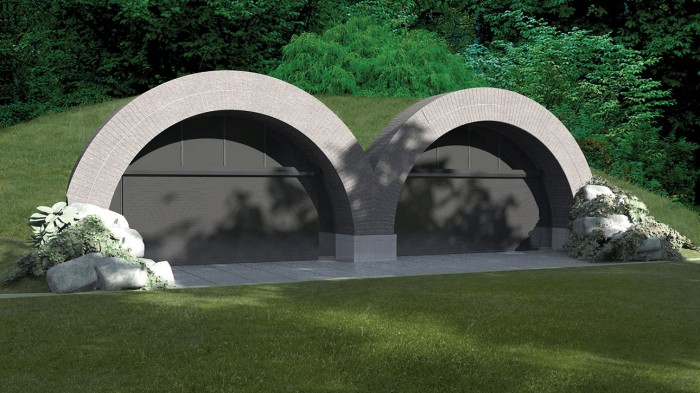
Human elements
Still, there’s a fundamental weak spot in Australia’s bushfire building standard, and that’s people.
“They believe it’s somebody else’s problem, it will happen to somebody else and not me, that I’m much better prepared than everyone else around me,” says Bushfire and Natural Hazards CRC’s Richard Thornton. “The constant refrain that we have across all of these fires … has been people understand that they live in a bushfire-prone area, like you do in the Blue Mountains, but they don’t believe it’s a problem for them.”
A 2018 study among communities affected by bushfire in the state of New South Wales found that around half of agricultural holdings were underinsured, partly because insurance was so costly. Estimates from the Black Saturday fires in Victoria suggest that 80% of those affected were underinsured and 13% were not insured at all. The insurance industry blames “charity hazard”— the notion that people assume the government will step in and help them.
People also aren’t good at fire safety measures. Expert advice says it’s important to maintain a home’s “asset protection zone”—that is, to make sure the area around a house contains as little flammable material as possible. The greater the bushfire threat, the larger that area needs to be. Other countries have a similar approach: the US National Fire Protection Association’s “Home Ignition Zone” is an area 100 feet (30 meters) out from a home where residents are advised to keep vegetation to a minimum and remove flammable materials such as firewood.
But keeping this up takes time and effort. “If you believe that your chance of being impacted by bushfire is once in 50 years, maybe, why would you spend one of your weekends each year doing something about it when there’s all the other things about bringing up kids, going to work, doing all the other things you have to do?” Thornton says.
One person with a suggestion of what to do is Rachel Westcott, a researcher who has been trying to promote the idea of “fire fitness”—a more practical vision of preparedness that accepts fires as a bigger part of the landscape now.
“Fire fitness means to be prepared and be ready, but it means integrating that into everyday life,” says Westcott, who recently completed her PhD at the Bushfire and Natural Hazards Cooperative Research Centre and Western Sydney University. “It means having that fitness to be able to face that hazard and deal with it safely and make the right response choices and come out of it more or less unscathed.” She notes that public resources are being invested to help people become more bushfire ready, but the level of awareness and readiness is not rising as fast as spending is.
Her research found that fear-based safety campaigns don’t work for everyone, and even when they do, their effect plateaus and fades over time. Fire fitness, she argues, is about creating incentives: for example, workplace leave that is specifically intended for employees to prepare their properties ahead of severe fire weather, and insurance discounts or tax breaks for well-prepared properties and people.
As Australians keep building further and further into fire zones, fire fitness becomes ever more important. In the Blue Mountains, new blocks of land are constantly being released for sale. They’re cheap, they’re bushy, and many are in the flame zone.
Australians’ unwillingness to part company with the bush, despite the threat, is evident even among people already traumatized by fire. Few want to relocate to safer territory. After Black Saturday, the Victoria state government started a land buyback scheme for some people who lost homes in the fires. One report suggested that while 550 homes were eligible, only 27 landowners took up the offer. A similar phenomenon is seen in other fire-afflicted places, such as California and Greece, where survivors are quick to start rebuilding their scorched houses and communities. One report on 11 major California fires between 1970 and 2009 found that 94% of damaged buildings were rebuilt, either by the original owners or by someone else. In Greece, development laws have loopholes that enable people to build in highly fire-prone areas, often without consideration for building regulations.
Few people want to relocate to safer territory, even if they have been traumatized by fire. After Black Saturday, the government initiated a land buyback scheme for those who lost their houses in the fire. Though 550 homes were eligible, only 27 landowners took up the offer.
Susan Templeman, the federal member of Parliament for the Blue Mountains, is one of those who lost nearly everything to fire yet are willing to risk it again to remain in their communities. Her home was destroyed in the same bushfires that my family fled, but she and her husband have since rebuilt on the same spot. Unlike many people, she was able to afford the increasing costs of building a code-worthy home in fire zones. But it still took the family over four years to design and build a home that is as bushfire resistant as possible. “We think our house is going to be fairly resilient to heat and embers,” she says. So would they entrust their lives to it if—when—fire returns to their area? “As interesting as it would be to test that,” she says, “I don’t believe that we would stay.”
Getting it right
On a hot January day this year, I drove to nearby Mount Victoria, the small village where one of the three Blue Mountains fires began. It’s clear where the fire struck: I drove past one block of land for sale that still carries the remnants of a house that went up in flames. Somebody will probably buy the plot soon. Most of the other houses on the same street are shiny and new—testament to residents’ will to defy the odds.
In February, Australians marked the tenth anniversary of Black Saturday. Yet even as the nation mourned in remembrance, large areas of Tasmanian wilderness smoldered after two weeks of uncontrollable blazes. Barely a week has gone by this summer without someone, somewhere in the country, being told to grab what they can and get out.
So are the changes in policy, regulation, and building codes having an impact? Are Australians learning the lessons of Black Saturday fast enough?
Richard Thornton says Australia’s relationship with fire has always been different from other countries’. “Europeans have dealt with and lived with agricultural fire for a long time, but not necessarily forest fires as such,” he says. And while US states like Florida and Louisiana have been doing prescribed burns for decades, Thornton argues that other regions have the attitude of “extinguish at all costs,” which means that when fires do occur, they get enormous. The problem is compounded by infestations of mountain pine beetle across the US and Canada, which leave behind huge areas of dead trees as fuel for forest fires.
CSIRO’s Justin Leonard says Australia has some of the best examples of getting bushfire-ready building right, particularly in contrast to the lightweight, polyvinyl chloride–clad, bitumen-roofed pine frame houses that dominate in the United States.
But he also believes a lot of its efforts still fall into the “epic fail” category. The stringent bushfire building code is, he suggests, a minimum standard for homeowners who aren’t really aware of, or prepared for, the true threat they face.
Even then, he says, it’s not enough: “Either the safety net has to be robust enough that it can perform well in the absence of an expert or informed user, or we’ve got to work out how to shift the demographic of attitudes in the community.”
But perhaps attitudes are starting to shift in the right direction, particularly when it comes to choosing to evacuate early rather than stay and defend. Thornton points out that very few people have died in big fires since Black Saturday.
“It’s always a portentous thing to say,” he notes. “Whether that’s good planning, and therefore everything that we’ve changed since Black Saturday has worked, or whether that’s just good luck—we’re not sure yet.”
Keep Reading
Most Popular
Large language models can do jaw-dropping things. But nobody knows exactly why.
And that's a problem. Figuring it out is one of the biggest scientific puzzles of our time and a crucial step towards controlling more powerful future models.
How scientists traced a mysterious covid case back to six toilets
When wastewater surveillance turns into a hunt for a single infected individual, the ethics get tricky.
The problem with plug-in hybrids? Their drivers.
Plug-in hybrids are often sold as a transition to EVs, but new data from Europe shows we’re still underestimating the emissions they produce.
Google DeepMind’s new generative model makes Super Mario–like games from scratch
Genie learns how to control games by watching hours and hours of video. It could help train next-gen robots too.
Stay connected
Get the latest updates from
MIT Technology Review
Discover special offers, top stories, upcoming events, and more.